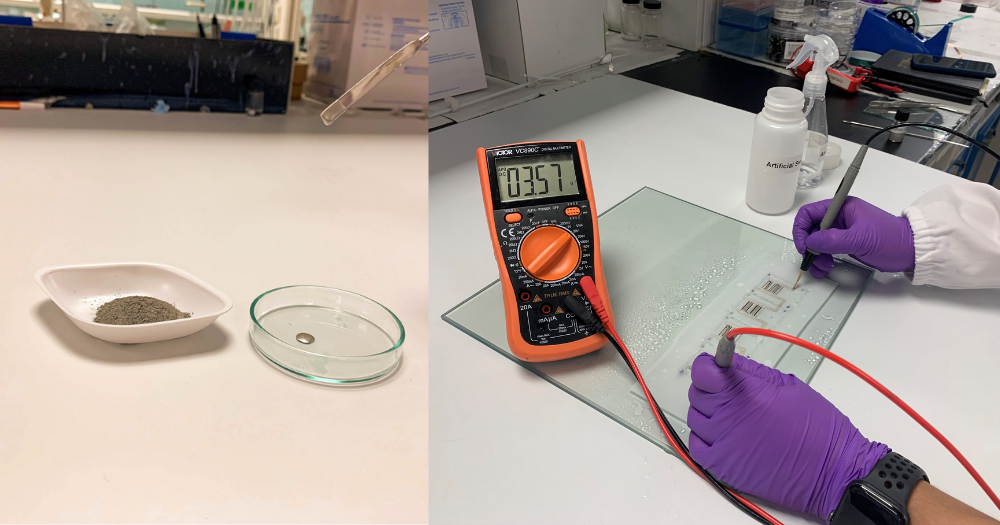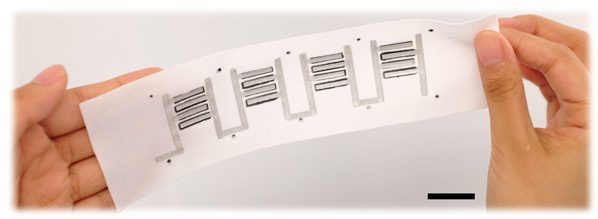Follow us on Telegram for the latest updates: https://t.me/mothershipsg
A team of researchers at Nanyang Technological University (NTU) have developed a 2cm by 2cm battery powered by human sweat.
As flat as a bandage, the prototype battery is soft and stretchable, and consists of printed silver flake electrodes that generates electricity in the presence of sweat.
The size and efficiency of the battery also makes it ideal for use in wearable tech like watches, wrist bands, or arm straps.
In one trial, the battery could generate enough power for a commercial temperature sensor device to continuously send data to a smartphone via Bluetooth.
The battery was worn around the wrist, with the wearer cycling on a stationary bicycle for 30 minutes. The battery generated a voltage of 4.2 V and an output power of 3.9 mW.
 Photo by Jian Lv, Nanyang Technological University.
Photo by Jian Lv, Nanyang Technological University.
The study was published in July, and a patent application has been filed through NTU’s enterprise and innovation company, NTUitive.
How it works
The battery was made by printing ink onto a stretchable textile.
The ink contains silver flakes and hydrophilic poly(urethane-acrylate) (HPUA) which function as the battery electrodes.
When exposed to sweat, a chemical reaction occurs in the battery.
The acidity and chloride ions present in sweat cause the flakes to clump together, which increases their ability to conduct electricity, allowing an electric current to flow between the electrodes.
 Left: Silver flakes used to create the battery. Right: The battery generated a voltage of 3.57V after being sprayed at with artificial sweat. Photos by NTU Singapore.
Left: Silver flakes used to create the battery. Right: The battery generated a voltage of 3.57V after being sprayed at with artificial sweat. Photos by NTU Singapore.
A previously unreachable milestone for wearable devices
Seeing that sweat is a "near-guaranteed source of energy produced by our bodies", Lee Pooi See, the professor who led the study, expects the battery to be capable of powering "all sorts of wearable devices".
The battery conveniently resolves two obstacles in wearable tech, by allowing devices to achieve the attractive sleek aesthetics attractive to consumers while still being able to carry enough charge to last throughout the day.
Irene Goldthorpe, an associate professor from the University of Waterloo, said that the prototype battery may open a "new paradigm" in the design of wearable electronics.
He explains that wearable devices are typically fully encapsulated to shield them from sweat, as electronics do not work well with moisture.
In an impressive feat, by using sweat as an electrolyte in a wearable, bendable battery, the researchers managed to turn sweat "from a hindrance into an asset".
 Photo by Jian Lv, Nanyang Technological University.
Photo by Jian Lv, Nanyang Technological University.
A sustainable alternative for batteries
The NTU-made battery has the potential to be a more sustainable and non-toxic alternative for wearable devices, reducing harmful electronic waste.
According to the team, while conventional batteries often use unsustainable materials that are harmful to the environment, the stretchable battery does not contain any heavy metals or toxic chemicals.
While cheaper and more common, "(conventional batteries) are also potentially harmful in wearable devices, where a broken battery could spill toxic fluids onto human skin," said Lyu Jian, a research fellow from NTU’s School of Materials Science and Engineering.
More durable than current technology
The stretchable battery can "withstand strain from a wearer’s daily activities, and repeated exposure to stress or sweat," said Lee.
As the resistance of the battery is further lowered when the battery material is stretched, it is also perfect for use during exercise.
The battery can remain powered even when the user is not perspiring throughout the day as the stretchable textile is very absorbent and can retain a lot of sweat.
The researchers plan to further investigate other factors that may affect the performance of the battery, such as body heat and the different components of human sweat.
Follow and listen to our podcast here
Top images via NTU Singapore.
If you like what you read, follow us on Facebook, Instagram, Twitter and Telegram to get the latest updates.
